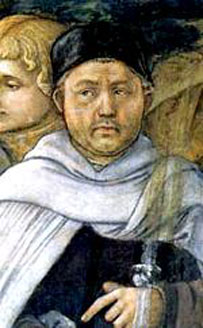 |
| Autoportrait of Fra' Filippo Lippi |
Fra Filippo Lippi
AKA: Filippo Lippi
Born: c. 1406
Birthplace: Florence, Italy
Died: 10-Oct-1469
Location of death: Spoleto, Italy
Cause of death: unspecified
Gender: Male
Religion: Roman Catholic
Race or Ethnicity: White
Sexual orientation: Straight
Occupation: Painter
Nationality: Italy
Executive summary: Coronation of the Virgin
What a small world it is....
In 2005 I studied art history at the Lorenzo Di Medici Art institute in Florance, Italy for 2 months. During our summer of classes, we the students had to choose 1 renaissance artist to study and recreate a new work of art that some how paralleled the story of this chosen artist from the past.
I chose Filippino Lippi the son of a Italian Monk, Friar, or Brother of the Roman Catholic Church. His father was Fra Filippo Lippi.
Today at my blogging headquarters, caffè letterario, a tourist couple from Switzerland kept asking me where is the museum with the famous renaissance paintings. As any good ambassador would respond I said "whaaaat? We don't have that type of museum here..."
After pulling out my library card for 1 hour of free internet service on the boxes of shit we call computers here, I started my search... What I found out is that the father of this artist child I had studied the life of, actually lived here in Spoleto, painted the famous frescoes at out Duomo and in fact died in Spoleto. Hum, I thought... time for me to do some researching...
Then this evening I researched his father and found some mixed opinions of him floating out there in the world of internet information.
The rumors ranged from he was poisoned here and killed by Umbrian folks to he father several children and was a despicable Friar who was was endlessly committing sins.
The indisputable story he is was an amazing artists who then taught he son to be an even more remarkable artist. He was a man full of passion for the love of one beautiful woman and strayed between his desires for her and the church.
Here below are the 2 mains stories that seem to take different directions on one man's life which ended here in Spoleto in 1469 about 542 years ago.
http://www.newadvent.org/cathen/09278a.htm
The great artist lived in the continual embarrassments caused by his deplorable morals. Never was anyone less fitted for religious life. His portraits show us a flat-nosed individual with a jesting, but vicious looking, thick-lipped, sensual face. To compel him to work Cosmo de' Medici was forced to lock him up, and even then the painter escaped by a rope made of his sheets.
His escapades threw him into financial difficulties from which he did not hesitate to extricate himself by forgery. Callistus III was obliged to deprive this unworthy monk, "who perpetrated many nefarious crimes", of a benefice. In 1452 the Carmelite was requested by the commons of Prato to paint the choir of the cathedral.
At length, despite his evil reputation, Lippi succeeded in having himself appointed chaplain of a congregation of Augustinians. Here his misbehaviour was no less flagrant than elsewhere. It is significant and shows plainly what were the ideas of the Renaissance that Lippi was not punished for his bad conduct. Glory or genius then constituted a soil of privilege and a warrant of impunity. Talent placed its possessor beyond and above the moral law. Not only did Cosmo di' Medicimake merry over what he called the "folly of the frater" (Letter of J. de Medici, 27 May, 1458), but Pope Pius II thought he could do no better than to release him from his vows and permit him to marry. A son, Filippino Lippi, had already been born to him. He afterwards had a daughter (1465). In the midst of these intrigues and disorders Filippo continued to paint his greatest works.
http://www.nndb.com/people/825/000084573/
The close of Lippi's life was spent at Spoleto, where he had been commissioned to paint, for the apse of the cathedral, some scenes from the life of the Virgin Mary. In the semi-dome of the apse is Christ crowning the Madonna, with angels, sibyls and prophets. This series, which is not wholly equal to the one at Prato, was completed by Fra Diamante after Lippi's death. That Lippi died in Spoleto, on or about the 8th of October 1469, is an undoubted fact; the mode of his death is again a matter of dispute.
It has been said that the pope granted Lippi a dispensation for marrying Lucrezia, but that, before the permission arrived he had been poisoned by the indignant relatives either of Lucrezia herself, or of some lady who had replaced her in the inconstant painter's affections. This is now generally regarded as a fable and indeed a vendetta upon a man aged sixty-three for a seduction committed at the already mature age of fifty-two seems hardly plausible. Fra Filippo lies buried in Spoleto, with a monument erected to him by Lorenzo de Medici; he had always been zealously patronized by the Medici family, beginning with Cosimo, Pater Patriae.
Francesco di Pesello (called Pesellino) and Sandro Botticelli were among his most distinguished pupils.